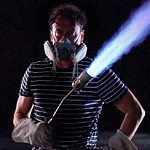BIOGRAPHY

Born: Charlotte, NC, 1958
ABOUT
Paul Rousso is an American-born visual artist and innovator. Educated at the California College of the Arts, his work is shown at galleries and art fairs around the globe.
A prodigious perfectionist, his technique has leapt into the future, as his vision and imagination merge to embrace new conceptual and physical technology the moment they appear on the horizon. The artist lives his context and vehemently pursues his objective.
Rousso relentlessly excels at his efforts to evolve as an artist who will put forth an enduring impact on subsequent generations with his life’s work, “Flat Depth.” This concept, which he has been refining his entire professional career, is the logical progression of modern art - to render a flat object three-dimensional, or to collapse a three-dimensional object into two dimensions - and is a fusion of countless complex artistic methods, including painting, printing, sculpting, welding, chemistry, digital manipulation and digital printing.
His first summer job - designing the Tribeca loft of Robert De Niro - combined with stints as a Hollywood scenic artist and a brief career steeped in the cosmetics industry as an art director at Grey Advertising on the Revlon account, lend a wry touch to the social commentary woven through his work, and his vast and encompassing worldview flavors everything he creates.
Rousso’s work is held in private collections over North America, Europe, the Middle East and beyond, and numerous public projects of his appear across the United States.
Raised in North Carolina, Rousso traces his inspiration to the paradoxes of the world around him and the work of the artists who began the conversation, as well as every artist through time who has advanced the subject or the art form. His work is deliberately attainable to nearly every viewer, and yet his classical training shines through as time-honored artistic conventions are woven through his work.
Rousso's fascination with paper - currency, advertising, newspapers, magazines - its history and use, its rise and fall, is an emblematic theme reflected frequently in his compositions. Despite the complexity of Rousso's artistic output, the character and subject matter of the art is relatable to all citizens of the world, so much so that it practically jumps off the wall, and straight into the viewer's gestalt.
Paul Rousso
by David P. Sprouse
The ink and paper era is drawing to a close. “All this stuff,” as artist Paul Rousso puts it, “is going away.” That “stuff” is no less than the paper-based underpinnings of modern civilization. Texts, images, sheet music, currency – the paper document is being displaced by its transformation into so many bits of binary code, digitized for the screen and everyplace at once. Yet paper documents are themselves an expression of something else entirely. An artist sketches a two dimensional impression of a flower; a novelist commits an imagined conversation to paper – meaning is imbued within a separate medium, altered yet understood.
From his “painting with paper” collages to his latest creations of wildly outsized and convoluted sculptures of money and candy wrappers, Paul Rousso has sought to flatten the dimensional and elevate the flattened: “There are many shades from one end of the spectrum to the other, but everything has an opposite. My work is about finding what comes next.” For Rousso, a good deal of what’s next involves a process of crumpling, folding, tearing, gluing, and re-composing – turning the printed pages of a single Vogue magazine into a sculpted wall hanging, for example, or transforming every printed note of every Beatles’ song into a massive jumble of texture on canvas.
With influences ranging from Dr. Seuss to Roy Lichtenstein, Rousso casts his pop art sensibilities on a 21st century scale. Advances in technology have enabled him to delve into the heat-tempered sculpting of the world’s ephemera in surprising ways. Through exaggerations of size, Rousso places such familiar items as a crumpled-up ten-dollar bill or a bubble gum wrapper on the same relative plane as the viewer. Intricately detailed renderings at such outsized dimensions as four to five feet in size force the viewer into the role of studied observer. It is in this way that Rousso’s art speaks to the conversion of physical objects and the effect of that transformation on the viewer. Again, “all this stuff is going away,” and Rousso wants you take a good long look.
A native of Charlotte, North Carolina, Paul Rousso attended the Cleveland Institute of Art in Ohio before being sidelined by a too-close encounter with a power saw. Rousso’s period of convalescence turned into a months-long stint in New York City, where he found work as a member of an interior design team drawing plans for the home of Robert De Niro. After completing his B.F.A. in 1981 at California College of the Arts in Oakland, California, Rousso was hired by Warner Brothers as a scenic painter for films. He went on to serve as an art director and illustrator for Revlon, Clairol, Condé Nast, and Bloomingdale’s before becoming a fulltime artist. For more than 25 years, Paul Rousso’s work has been regularly exhibited in galleries and museums throughout the United States.
